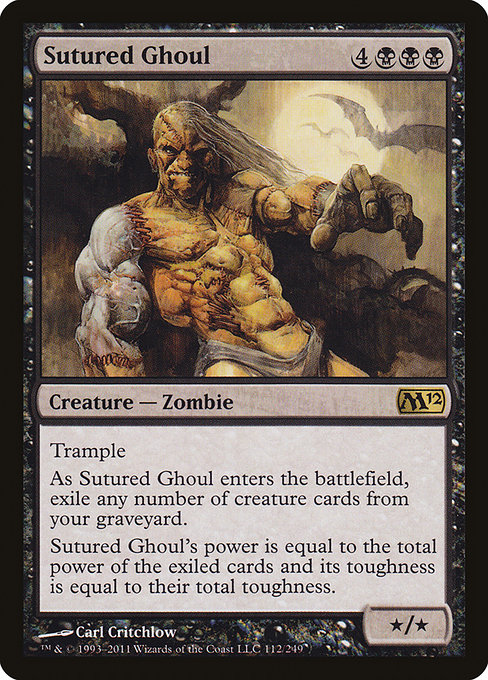
Image courtesy of Scryfall.com
Sutured Ghoul's Role in Multiverse Event Crossovers
Across the sprawling multiverse of Magic: The Gathering, crossovers and plane-hopping narratives give players a sense of shared mythos, as if different worlds are stitching their stories into one grand tapestry. Sutured Ghoul, a rare zombie from Magic 2012, embodies that theme in a mechanical form. With a hefty four colorless and two black mana, this creature arrives with trample and a unique enters-the-battlefield trigger: exile any number of creature cards from your graveyard, then let its power and toughness become the sum of those exiled cards. In other words, the dead you pull into the present feed the monster you’re about to unleash. The ghoul’s size scales dramatically with the quality and quantity of those exiled creatures, making every crossover moment feel personal and explosive. 🧙🔥
How the card’s mechanics echo cross-plane storytelling
The Multiverse is a concept built on what could happen when disparate stories collide. Sutured Ghoul translates that idea into a single, vigorous engine: it takes elements from one world—your graveyard—and channels them into another world’s threat on the battlefield. In a hypothetical multiverse crossover event, you could imagine the ghoul absorbing creature cards from diverse plane histories and mythologies—zombies from Innistrad’s haunted halls, behemoths from Zendikar’s shifting landscapes, or reanimated legends from other eras—creating a single, unstoppable force that carries memories from across the cosmos. The more varied the exiled creatures, the more diverse the ghoul’s power and toughness become, a perfect metaphor for how crossover narratives fuse different legacies into a singular clash. ⚔️
Strategic angles for cross-format play
- Graveyard-first rhythm. Sutured Ghoul rewards players who thoughtfully populate their graveyard with substantial creatures ahead of its arrival. The larger and stronger those exiled cards are, the more dramatic the payoff when the ghoul hits the battlefield. This is classic cross-format necromancy energy—memories become muscle. 🧙🔥
- Timing matters. Since the exile happens as it enters, you’ll want to cast it into a turn where you can guarantee a healthy pool of creature cards in your graveyard. That sounds simple, but in crowded Modern or interactive Commander games, the right timing can swing the entire game state. 🔎
- Long-game inevitability. In formats like Modern and especially Commander, Sutured Ghoul can serve as a late-game hammer that develops from a memory bank into a literal behemoth. It’s the kind of card that turns planewalker table talk into a single attacking threat that forces opponents to split resources. 💎
- Graveyard synergy toolbox. Pairing Sutured Ghoul with graveyard-filling engines and creatures with chunky stats in your deck creates a reliable exiled pool. The more you curate that pool, the more you confess your plan to the table—and the bigger your ghoul will be when it finally stomps in. 🎲
“Power, bound to the memory of forgotten battles, grows when the dead walk again.”
Artistically, the card captures the near-mythic vibe of necromantic workmanship. Carl Critchlow’s illustration presents a hulking zombie of patchwork sinews, a creature that looks as if it were stitched together from battles and eras—an ideal visual for a card designed to weave stories from across the Multiverse. The flavor isn’t just about raw numbers; it’s about crafting a narrative where the dead lend their voices—and their strength—to the living fight. The M12 era’s bold, timeless frame and the black border emphasize the ominous power of uncontrolled necromancy, making Sutured Ghoul a memorable centerpiece for any graveyard-themed deck. 🎨
Live play and collectible pulse
In terms of playspace, Sutured Ghoul thrives in environments where memory and material collide—Commander tables with sprawling graveyard strategies, Modern builds that lean into long-range win cons, and casual kitchen-table games where players enjoy dramatic turns that hinge on how many creatures you’ve exiled. The card’s rarity—a rare from Magic 2012—puts it into interesting territory for collectors as well. Market numbers from the card’s era show it’s a practical staple rather than a skyrocketing collectable, with foil variants typically priced higher than their nonfoil counterparts. Still, its flavor and mechanics offer enduring appeal to players who relish a black, graveyard-centered engine that scales unpredictably with the depth of your strategy. 🧪
And since we’re all about the vibe as well as the value, a tidy desk setup can elevate your game-night ambiance. If you’re into keeping your play area organized and phone-friendly, a sturdy phone stand makes a surprisingly nice companion for long drafting sessions or online tournaments. It’s a small desk upgrade that fits right in with the ritual of planning multiverse-crossing strategies. 🎲